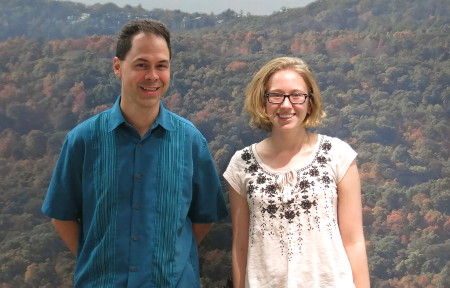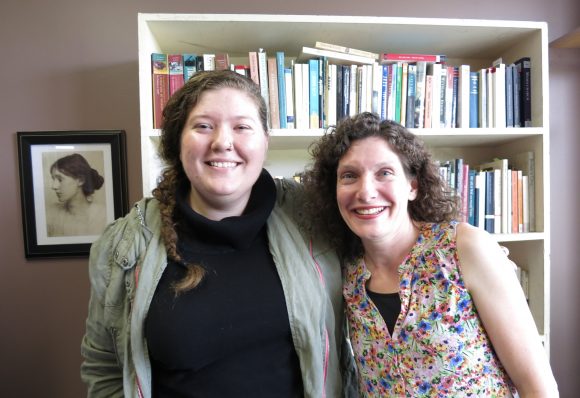Original Research Projects Rewarding for Students and Faculty
Though student-faculty research projects are often outgrowths of faculty’s existing research programs, some collaborations are spurred by students’ original ideas. As faculty members guide and mentor students through the research process, they often see their own work in new and interesting contexts.
Such is the case of two current collaborations in the liberal arts, which have received funding through the Summer Undergraduate Research Experience (SURE) and the Academic Year Undergraduate Research Experience (AYURE). This summer, Leah Mancini ’17 (Psychology) conducted a study of play in nursing home residents, mentored by Douglas Maynard, professor of psychology, and Brianna Best ’17 (English) began an exploratory research project this fall entitled, “A Relative Canon: Twentieth-Century Women Writers and the Discourse of Physics.” Best is being mentored by Vicki Tromanhauser, an associate professor of English.
Both SURE and AYURE awards are administered by the Office of Academic Affairs’ Research, Scholarship, and Creative Activities program, which encourages and supports connections between undergraduate student learning and faculty scholarship.
Play in Nursing Home Residents
Maynard’s research focuses on the study of games as they relate to social interaction, cooperation, well-being and other aspects of the emerging field of positive psychology. For over a year, Mancini has been a member of Maynard’s research team, the Positive Play Lab, which studies play, playfulness and gaming in adults.
For her SURE project, Mancini applied her work in the lab to a unique population – elderly nursing home residents. Very little has been written about play in the elderly population, but Mancini discovered one small case study that found that nursing home residents who played were less depressed, less isolated and more active.

For her study, Mancini interviewed 15 residents of Mountain View Nursing and Rehabilitation Center, who ranged in age from 72-97. She sought to discover how participating in play affected the nursing home residents’ wellbeing, and to discover how play changes throughout adulthood.
In developing the research methodology, Mancini and Maynard reviewed books on qualitative interviewing and grounded theory. Maynard noted that, unlike quantitative research, Mancini’s study captured data “in language rather than numbers.”
“Grounded theory and quantitative analysis in general is a lot more exploratory, in that you don’t have a preset hypothesis to test. You have a broader phenomenon that you want to explore and you go in and let those data speak for themselves and see what rises out of the richness of the interviews,” Maynard said.
Mancini practiced her interview questions on her 89-year-old grandmother, as well as Maynard’s parents and their friends. At the nursing home, she made adjustments when residents didn’t understand her questions. “I quickly realize that those questions weren’t working, and I changed them more to an unstructured interview,” noted Mancini. “I focused more on their lives in the nursing home and beforehand, and where play came up naturally, I explored it from there, rather than going in and just asking a set of questions each time.”
Over the summer, Mancini transcribed the interviews and developed a tentative model of nursing home play. “When I was interviewing [the residents], I noticed that once they got to the nursing home, the way that they wanted to play wasn’t really changing – if they liked golf before the nursing home, they still liked golf. But then there were barriers that they were facing either because of their physical condition, social reasons or the institution that they couldn’t continue playing the way that they used to. And I found that some people were able to change while others were just kind of depressed and sad about it,” Mancini said.
Along with other SURE recipients, Mancini presented her findings on campus on Sept. 8. In October, Mancini and Maynard attended the Meaningful Play Conference in Michigan. Mancini gave a poster presentation of her study, and Maynard gave an oral presentation of a study he conducted with Mancini and her peers in the Positive Play Lab.
Mancini and Maynard will continue their analysis of the nursing home residents’ interviews this academic year. Maynard described his work with Mancini as more challenging than typical student-faculty research projects.
“It’s a little bit easier to have in your mind, here’s exactly how it’s going to go, and you just supervise student researchers to make it happen. Supporting independent research that comes from the student has challenged me to find what I know and brush up on what I don’t so I can be of value to her as opposed to just delegating tasks to people. It’s good work; it’s more challenging than the other approach,” he said.
Mancini previously worked on two research projects for the Office of Institutional Research and currently works at the Benjamin Center for Public Policy. She hopes to pursue graduate studies in data analytics and public policy.
Mancini said she enjoyed the process of executing an original SURE project, work that felt “natural” for the gifted undergrad. “It really showed me what my future could be like,” she said.
Women Writers and the Discourse of Physics
As a teenager, Best was more interested in reading novels than studying science, but a dynamic high school teacher piqued her interest in the study of physics. As a college junior, she encountered the 1989 book Einstein as Myth and Muse, which rekindled her fascination with physics by demonstrating how Einstein’s theory of relativity inspired plot elements in Virginia Woolf’s To the Lighthouse.
Best wondered if discoveries in physics and other scientific innovations have informed the work of other female authors, and shared her thoughts with Tromanhauser, her professor in last fall’s “Introduction to British Literature” course. Tromanhauser, a Woolf scholar whose research focuses on modernism’s relationship to animality, food studies, and the life sciences, offered to help Best explore her ideas. Together, they wrote a successful AYURE application, which proposes to tell the “less recognized story of the vital exchange between physics and women’s writing in the twentieth century.”

Tromanhauser noted that writing about the sciences would have been intimidating particularly for women in the early 20th century, who didn’t have a formal education. Woolf was exposed to writers who popularized discoveries in physics for mass audiences. A goal of the research project will be to discover the popular sources of scientific writing that inform the works of Woolf (1882-1941) and lesser known American poet H.D. (Hilda Doolittle 1886-1961), as well as to consider how more direct exposure to the sciences informs the work of American science fiction writer Ursula K. Le Guin (1929-) and Canadian speculative fiction writer Margaret Atwood (1939-).
Le Guin came from a family of anthropologists, and Atwood’s father and brother studied forest entomology and biology, respectively. “Atwood is interested in breaking down divides between the sciences and the public, and she speaks openly about embracing scientific writing,” noted Tromanhauser.
Best described the research project as “exploratory,” in that it will not only make connections between physics and women’s writing, but also explore how women’s exposure to scientific innovations gave them freedom to explore complex and often taboo subjects like gender identity and sexuality. Best believes “there’s something radical about the way these women imagine their characters,” citing homoerotic elements in Woolf’s To the Lighthouse and gender transformations in Woolf’s Orlando and Le Guin’s Left Hand of Darkness.
Tromanhauser said the project will explore how “20th century discoveries about gravity change our understanding of what this elemental physical property is and [create] new character configurations that we see in novels, where same sex attachments are entertained rather than spurned.”
The work has already challenged Best and Tromanhauser to think outside of their areas of expertise. Best will draw upon her studies of literature, feminism and queer theory, but must also expand her knowledge of physics and other groundbreaking scientific discoveries. She plans to immerse herself in a number of books purchased through the AYURE grant that address the intersection between science and literature and explain difficult scientific concepts in layman’s terms. She also plans to discuss her project with a physics professor on campus.
Tromanhauser said the project has taken her “a little farther outside of my expertise, which is thinking about human-animal studies and representations of the nonhuman in literature, to different types of scientific questions, not ethology and biology, but physics,” work she finds fascinating.
“Brianna’s teaching me aspects of physics that I never had a formal training in beyond high school, and dimensions of writers who I frequently teach, but haven’t taught through these particular connections, so that’s marvelous,” she said.
